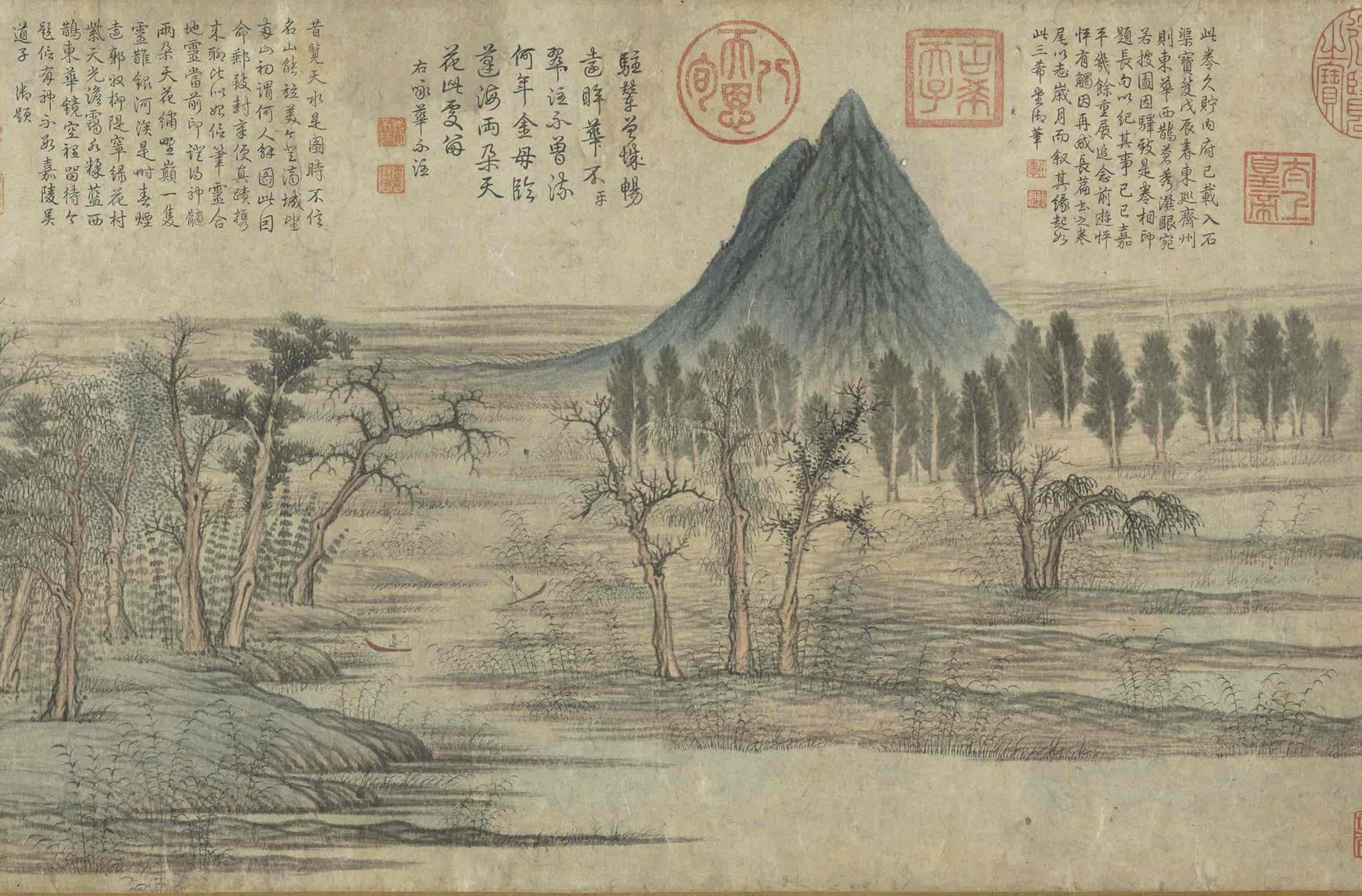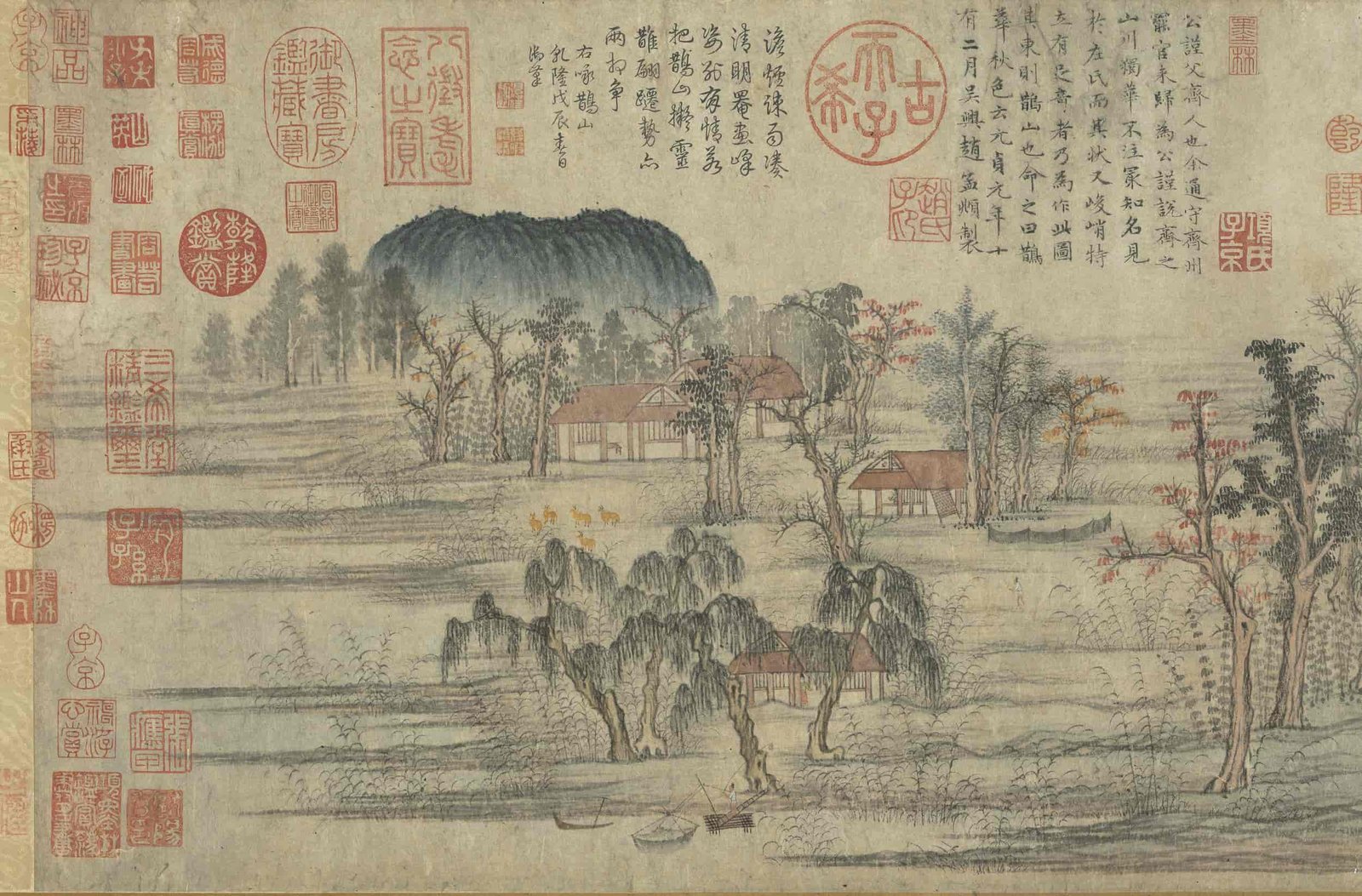Zhao Mengfu’s Autumn Colors at the Qiao and Hua Mountains (《鹊华秋色图》)
A masterpiece of Yuan Dynasty (1271–1368) literati painting, Autumn Colors at the Qiao and Hua Mountains by Zhao Mengfu (赵孟頫, 1254–1322) is celebrated as a pinnacle of “blue-and-green” landscape art infused with poetic nostalgia. Painted in 1295 on silk (28.4 cm × 99.6 cm), this scroll, now housed in the National Palace Museum, Taipei, blends documentary realism with idealized memory to soothe the homesickness of Zhao’s friend Zhou Mi (周密), a Southern Song loyalist who had never seen his ancestral homeland in Jinan, Shandong.
Historical Context and Symbolism
- Patronage and Purpose: Zhou Mi, a scholar-official of Southern Song descent, yearned for his ancestral roots in Jinan. Zhao, who served as a magistrate in Jinan (1289–1293), crafted this scroll as a “virtual homeland” for Zhou, merging geographical landmarks (Mount Hua 华不注山 and Mount Qiao 鹊山) with poetic license to evoke an idyllic, untroubled past.
- Political Subtext: As a descendant of the Song imperial family serving the Mongol Yuan court, Zhao’s work subtly negotiates cultural loyalty. The tranquil landscape, free of human strife, mirrors his ambivalence toward political service and nostalgia for Han Chinese traditions.
Artistic Innovation
- Stylistic Synthesis:
- Blue-Green Palette: Zhao revitalized Tang Dynasty’s “blue-and-green” technique (qinglü 青绿), using mineral pigments for Mount Hua’s azure peaks and Mount Qiao’s softer indigo. The interplay of cool hues (blues, greens) with warm accents (ocher for riverbanks, vermilion for rooftops) creates a harmonious autumnal atmosphere.
- Brushwork: Employing hemp-fiber texture strokes (pima cun 披麻皴) for mountain contours and lotus-leaf wrinkles (heye cun 荷叶皴) for Hua’s jagged slopes, Zhao balanced Tang monumentality with Song lyricism. His “archaism” (guyi 古意) rejected Southern Song academic rigidity, favoring expressive simplicity.
- Composition:
- The scroll juxtaposes Hua’s “sharp triangle” with Qiao’s “rounded dome,” separated by a misty river valley dotted with fishing boats, cottages, and groves. This spatial compression, merging distant landmarks into a cohesive vista, reflects Daoist ideals of cosmic unity.
- Human Presence: Tiny figures—fishermen casting nets, a scholar strolling—embody rural serenity, contrasting with Zhou Mi’s urban exile and Zhao’s bureaucratic burdens.
Provenance and Legacy
- Collectors’ Journey: From Zhou Mi to Ming connoisseurs like Xiang Yuanbian (项元汴) and Qing Emperor Qianlong (who inscribed 9 colophons and 57 seals), the scroll became a cultural trophy. Qianlong famously compared it to Li Gonglin’s Lotus Society (《莲社图》), enshrining it in the Shiqu Baoji imperial catalog.
- Modern Diaspora: Transported to Taiwan in 1949, it remains a centerpiece of Taipei’s collection, symbolizing both artistic triumph and historical displacement.
Key Inscriptions and Critical Reception
- Zhao’s Colophon:
“Gongjin’s father was a man of Qi. Having governed Qi, I now paint its mountains for him. Hua’s majesty, recorded in the Zuo Commentary, and Qiao’s gentleness—let this scroll be called Autumn Colors at Qiao and Hua.”
- Dong Qichang’s Praise (1602):
“Zhao’s genius synthesizes Wang Wei’s Tang elegance and Dong Yuan’s Song vigor—neither overly delicate nor crude. He transcends imitation, unlike those enslaved by antiquity.”
- Emperor Qianlong’s Obsession:
After visiting Jinan in 1748, he commissioned replicas and lamented Zhao’s “geographic error” (placing Qiao east of Hua). His poems and seals dominate the scroll, reflecting Qing imperial cultural appropriation.
Zhao Mengfu: Between Two Worlds
A polymath (calligrapher, poet, statesman) and 11th-generation descendant of Emperor Taizu of Song (赵匡胤), Zhao’s service to the Yuan court branded him a “collaborator” among Song loyalists. Yet his art—exemplified by this scroll—bridged Mongol patronage and Han literati identity, preserving Southern cultural memory during Mongol rule.
Legacy: The scroll’s fusion of topographic realism and emotional resonance influenced later masters like Huang Gongwang (Dwelling in the Fuchun Mountains). Its digital recreations (e.g., 2021 immersive exhibitions) continue to shape contemporary Chinese landscape aesthetics.



评价
目前还没有评价